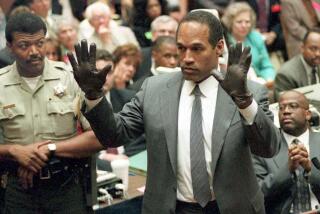Amazing Discovery: These Shows Are Ads
- Share via
Television is a huckster and viewers are its targets.
From news programs that promote themselves and their network’s entertainment programs to talk-show guests pitching books and movies.
From children’s programs tied to commercial products to electronic preachers who buy time on stations to sell their brand of religion and morality.
From political candidates who lure cameras with publicity stunts to professional experts who get themselves booked on public affairs shows to sell themselves and their causes.
All of these are the commercials between the commercials, a mostly sorry state of affairs as endemic to television as the airwaves themselves.
Since the mid-1980s, however, another, even trickier commercial trend has flourished in the television marketplace.
Now, in greater numbers than ever on independent stations and cable, comes that master of camouflage and shiftiness, the half hour or hour that looks like a program, acts like a program, sounds like a program, surely sometimes is mistaken for a program, but just as surely isn’t a program.
Now comes the infomercial.
Why look, it’s “Secrets of the Rich & Successful” with Fred Lewis. And here is Fred, a la Robin Leach, going into the pretentiously swanky home of how-to-get-rich-quick-even-if-you-have-no-money-or-credit-or-job lecturer Jeff McHone. Lewis looks around.
“Very impressive entrance.”
“Oh, thank you, Fred.”
It was the Federal Communications Commission, under the deregulating Reagan Administration, that flung open the door to infomercials in 1984 by erasing a guideline limiting commercial time on TV. The result was inevitable: Hundreds of mostly deceptive program-imitating commercials selling everything imaginable, mostly late at night or in the morning.
Some infomercials are comical.
Why look, it’s “TV Insiders With Investigator Vince Inneo.” See Vince, wrapped in his trench coat and carrying his briefcase, fly in his private jet to Phoenix for a penetrating interview with Royden Brown, who tells the earnest Vince that the bee pollen he markets can cure just about everything, including impotence.
Vince dutifully reads a letter from a satisfied customer who calls himself “a dud at 70, a stud at 80.”
Some infomercials are clearly irresponsible, if not outright dangerous. A short-lived one selling miracle crystals (pouch and polishing rag included) trumpeted a letter from a woman saying that after she “worked” with one of the crystals, the lump in her breast disappeared.
Most infomercials are misleading.
The trend is causing concern on Capitol Hill. One subcommittee of the Congressional Committee on Small Business has already held hearings on infomercials, and a second subcommittee has scheduled additional hearings for March 21.
“We’re interested in commercials that are devised to disguise their commercial nature,” said Rep. Norman Sisisky (D-Va.), who headed the first subcommittee’s hearings. “When they’re set up to look like talk shows and news shows, that becomes a federal trade issue.”
The congressional interest is refreshing in view of past federal acquiescence on the infomercial maze.
Although the Food and Drug Administration (FDA) in January banned the sale of over-the-counter products “claiming to grow hair or prevent baldness,” infomercials selling such products reportedly have continued running in some areas. The FDA says that the actual anti-baldness advertisements are beyond its jurisdiction and a matter for the Federal Trade Commission (FTC), but the FTC does not appear very interested in the infomercial issue.
At the very least, the federal government should require infomercials to be identified as advertisements throughout. The present requirement calls for one label at the beginning of the infomercial, but many carry labels at the end as well.
Even with frontal and rear labels, infomercials can still be extremely misleading, not only because they usually carry program-like titles (“What You Don’t Know Can Hurt You With Alex Trebek,” featuring the game-show host interviewing the promoter of a memory course), but also because they bear so many other characteristics of conventional programs:
There’s the documentary, a la “Secrets of the Rich & Famous.” There’s the newscast, a la “Discover With Robert Vaughn” that (until the FDA ban) has marketed the anti-baldness Helsinki Formula by simulating a news story featuring Vaughn as a sort of anchorman in touch with various international locales. There’s the late-night talk show, a la actress Erin Gray interviewing the exotic Anushka about her anti-cellulite body contour plan and taking testimony from a studio audience of beauties who resemble Stepford Wives.
The classic look-alike, though, is “Geraldo”-cloning “Amazing Discoveries,” the umbrella title for infomercials selling a variety of products. The subject of today’s in-depth probe is Natural White:
“I’m Mike Levy, and that’s our focus on this edition of ‘Amazing Discoveries,’ ” booms host Levy, who proceeds to elicit testimony from members of the studio audience who, one after the other, credit Natural White with brightening not only their teeth, but also their lives.
One of them is a chain-smoker who says that his three-pack-a-day habit stained his teeth until Natural White entered his life. Then voila , all white!
But check his lungs.
Like most infomercials, “Amazing Discoveries” includes program-like commercial breaks, which are merely a separate guise for selling the same product being featured in the other part of the infomercial.
The use of Levy on all “Amazing Discoveries” infomercials is part of a shrewd marketing strategy, says Rader Hayes, an assistant professor of consumer science at the University of Wisconsin.
“Media Arts and International (which produces “Amazing Discoveries”) figured out that the way to increase the credibility of a show is to have the same personality come on all the time,” said Hayes, who studies infomercials closely. Home shopping shows successfully use the same tactic, she said.
Hayes believes that even when properly identified, program-length commercials are still potentially confusing or even misleading because the symbols of legitimacy they employ are often so powerful as to override the labeling. She says she’s even been fooled herself.
One of the most successful of the infomercials is reportedly the hopelessly hammy Richard Simmons’ half hour promoting his Dial a Meal weight-loss plan. With sentimental background music setting the tone, he and his satisfied customers sit on the floor as they tell him how wonderful he and his diet program are.
In one segment, it’s his brother and mother who sit opposite him. They ultimately hug and kiss. In another segment, he shows a woman a photograph of her former fatter self, and she weeps. And in still another segment, a 250-pound woman who once weighed 900 pounds says: “I’m so very proud that I met you, and you’ll always be a part of my life.”
The message is almost spiritual, with Simmons somehow getting elevated here to a level only slightly below deity.
“Whether he really cares about these women is not the point,” said Hayes, who believes this is an example of a positive infomercial. “He provides good information and he doesn’t make false promises. He doesn’t promise they will lose slabs of weight at once. He tells them that if they are going to be the best they can be, they have to change their life, exercise, change what they eat and feel good about themselves.”
As for most other infomercials, however, viewers should take to heart the title of Alex Trebek’s half hour mentioned above: “What You Don’t Know Can Hurt You.”
More to Read
The complete guide to home viewing
Get Screen Gab for everything about the TV shows and streaming movies everyone’s talking about.
You may occasionally receive promotional content from the Los Angeles Times.






